Propagate Clematis through Cuttings and Layering are famous ideas to generate more plants by using the parent or well-grown plant. Propagating Vines or herbs of the buttercup family also known as Clematis – Sounds intimidating, right? It’s not.
We’ve got you all covered! We’ve prepared a step-by-step guide for you to learn how to propagate Vines or herbs of the buttercup family in both cutting and layering with all the necessary materials, tips, and the differences between cutting and layering Propagation.
Propagating Clematis (Vines or herbs of the buttercup family) by Layering
So what is Layering? Layering is a process in which a specific plant’s steam or branch is bent inside a soil still attached to its roots so the steam or the branch can generate its roots to sustain itself.
Layering is one of the easiest and most natural ways to propagate or breed the clematis on its own. However, the layering technique will not work in cold climates as the steam dies after it reaches the ground.
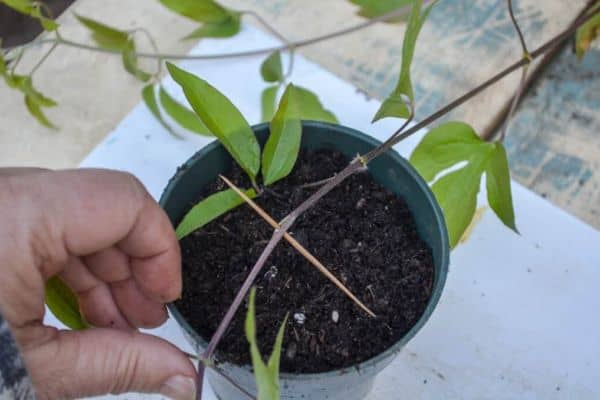
The Materials you’ll need for layering propagate clematis:
- Parent plant
- Rooting hormone
- Knife
- Pot
Here are some of the lists on how to propagate clematis through layering:
Step 1: Select or choose a steam of a clematis plant you want to do layering. Identify whether the selected steam is flexible and long enough for it to reach the soil.
Step 2: Now prepare the steam and a sharp knife to make a small cut on the steam where it makes contact with the steam. On the cut part, you can also apply a powder called rooting hormone which helps the steam generate roots faster.
Step 3: After the cut is done cover the cut seam about half-inches to an inch in the soil. The cover can be done on the ground or in the pot and secured with the rock or garden pines.
Step 4: After securing the seam on the soil you have to keep the steam moist and disturb the steam as much as possible like not moving the steam or taking it out of the soil.
Step 5: After the course of one or two years the seam will likely be developed to a small plant as its steam will be grown. Once the new growth is complete you can remove the cut steam with roots off the parent plant and move the plant to where ever you want to grow.
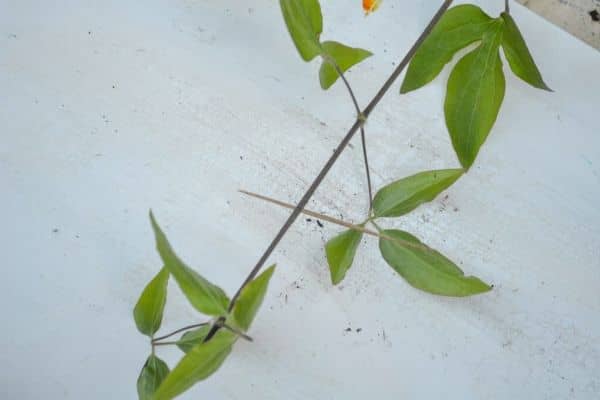
Pros and Cons of Propagating Clematis by Layering
| Pros | Cons |
| Layering Clematis is safer and more effective than other forms of Propagating. | Layering Clematis are lot more time-consuming. |
| They can receive sufficient Water and nutrients for them to grow. | They might affect the parent plant as the Water and nutrients are distributed to other steams. |
| These Methods are a reliable method, doesn’t require seeds, and requires less professional equipment | The steam is fully dependent on its parent plant and roots for water and nutrients. |
| There’s no risk of overwatering. | It is limited to certain plants and cant be implemented to all of the plants |
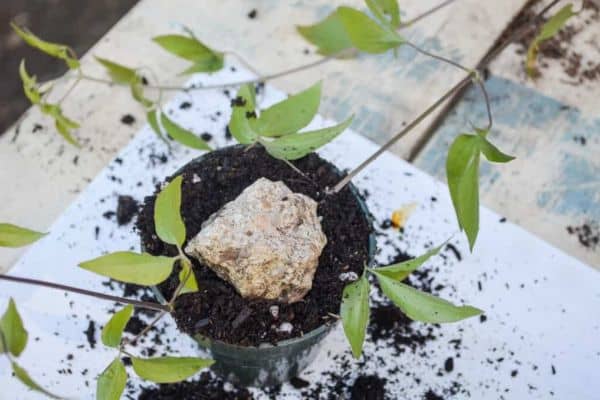
Propagating Clematis (Vines or herbs of the buttercup family) by Cutting
So what is Cutting? Cutting is a process in which a specific plant’s steam or branch is cut down directly from the parental plant and planted in the soil so the steam or the branch can generate its roots to sustain itself.
Cutting is one of the easiest ways to propagate or breed the clematis on its own. However, the cutting technique may not work or generate its roots, and takes several tries to get success.
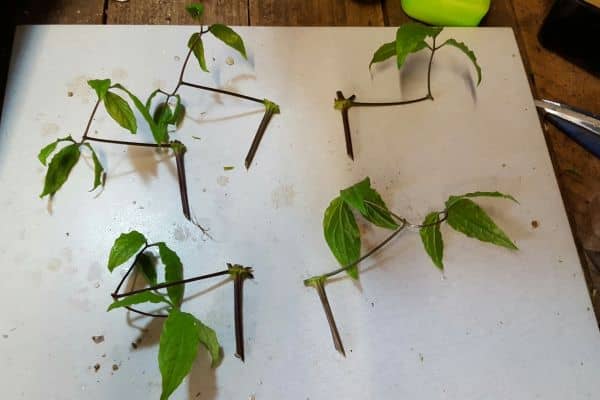
The Materials you’ll need for layering propagate clematis:
- Parent plant
- Rooting hormone
- Knife
- Pot
- Indirect light or artificial light
Here are some of the lists on how to propagate clematis through cutting:
Step 1: Select or choose a new growth or softer steam to propagate as those steams can produce their roots.
Step 2: Cut the chosen steam of the parent plant. The chosen steam must be cut off on the base.
Step 3: Remove the leaves of the modes from which the leaves sprout grow on either side. All you have to do is remove the leaves at the base of the cut steam and leave some leaves around each node.
Step 4: The cut steam or plant must be 3 to 4 inches long and the cut must be just below a mode. The cut steam must have a node and one to two sets of leaves.
Step 5: After the cut is done on the node you have to apply a rooting hormone which helps the steam generate roots faster and the rooting hormone must be 1 inch deep. After the rooting hormone is applied you have to let them dry for a few minutes.
Step 6: After the rooting hormone is done you have to prepare a container of 4 to 5 inches filled with moist soil and poke holes in the soil. The holes must be alongside the edges after that place the plant into the soil pressing the soil in the rooting hormone steam and holding it in place with the soil.
Step 7: After that in the course of two to three months depending on the environment and climate the roots will grow to sustain themselves. Just remember to place the panted pot in indirect light, bright, shades, or under artificial lighting. Also, remember to keep the soil moist.
Step 8: Once the steam starts to grow and take root you can move them into individual pots and provide them moisture and plenty of sunlight. You can also apply an organic fertilizer to the plant as per the product instructions to help it grow rapidly and prepare it for the season. As the plant grows you can plant them in the garden.
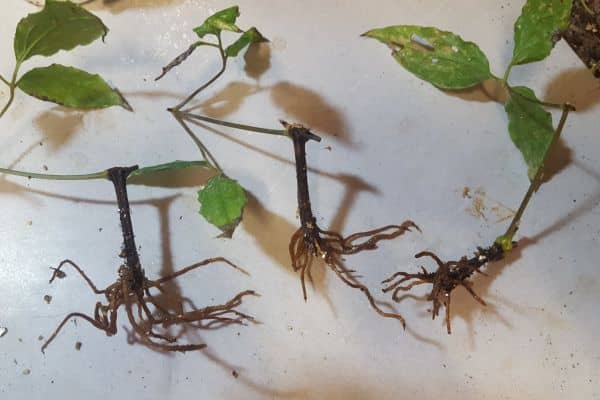
Pros and Cons of Propagating Clematis by Cutting
| Pros | Cons |
| Cutting Clematis can be done in massive as the steam with leaves is taken from the parent plant. | Cutting Clematis is less safe and effective as it may not grow steam |
| For cutting clematis you may need a lot of plant knowledge and professional equipment. | There is a risk of overwatering the plant |
| The plant will reach maturity at an earlier age. | You will get a lack of genetic diversity and you may potentially increase Insect and Disease weakness in the new plant. |
| You will get greater uniformity clones of your parent plants. | It is limited to certain plants and cant be implemented to all of the plants |
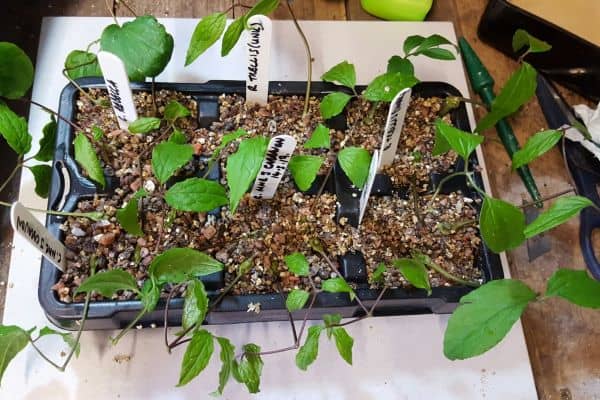
FAQs of Cuttings and Layering Propagate
Q. Can Layering Propagate be used in any plants?
No, you can’t use Layering Propagate in any plant as it requires flexible steam to be bent as some plants have hard steam it might break and then bend.
Q. What are the 4 main types of cuttings propagate?
The main 4 types of cutting propagation are Steam cutting, Leaf-cutting, Scion cutting, and Root cutting.
Q. How long do plant cuttings propagate last?
The cutting propagation takes up to two to three months depending on the environment, climate, light, and many more.
Q. Best season for Layering Propagate?
For Layering Propagate typically the spring or early summer is the best season as the plant can grow rapidly during those seasons. But it may be different for some plants.
Also Read: Top 10 Best Microgreens to Grow at Home!
